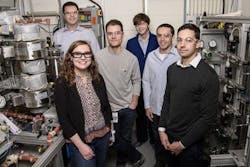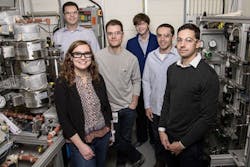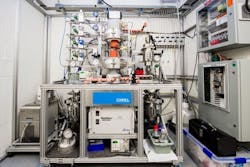Acrylonitrile Process Promises Potent Pluses
Pictured from left to right are Adam Bratis, Violeta Sànchez i Nogué, Todd Eaton, Gregg Beckham, Vassili Vorotnikov, and Eric Karp, part of the NREL team working on a cost-competitive, sustainable process for creating acrylonitrile and carbon fibers from renewable biomass. Source: Dennis Schroeder, NREL.
The route uses an inexpensive titanium dioxide solid-acid catalyst to transform ethyl 3-hydroxypropanoate from microbially produced 3-hydropropionic acid to acrylonitrile, explain the researchers. The 3-hydropropionic acid can come from non-food biomass such as agricultural wastes, they add.
Molar yields of acrylonitrile exceed 90% versus the 80–83% achieved in the well-established Sohio process. “This high acrylonitrile yield allows us to propose a potential industrial process for the conversion of lignocellulose to renewable acrylonitrile and carbon fibers,” notes Gregg Beckham, group leader at NREL and senior author of a recent paper in Science on the process.
NREL estimates the process can lead to an acrylonitrile selling price of under $1/lb, a level competitive with that of petroleum-based production.
“In collaboration with industry, we are going to scale up our work to produce 50 kg of acrylonitrile at the pilot scale. That will allow us to test a bio-based carbon fiber component to understand if the properties of bio-derived acrylonitrile differ from petroleum-based carbon fiber. We are also working towards improved catalyst development for the nitrilation chemistry, and are working to expand the nitrilation chemistry to other substrates to produce novel, bio-based nitrile compounds that can serve as polymer building blocks for new materials,” says Beckham.
The catalytic reactor is for converting chemical intermediates into acrylonitrile. NREL is working on producing renewable carbon fiber by extracting sugars from biomass, converting those sugars to an intermediate chemical, and then converting that chemical to acrylonitrile, which is the chemical building block for carbon fiber. The work is part of the Renewable Carbon fiber Consortium (RCFC). Source: Dennis Schroeder, NREL.
A number of issues require addressing, he admits.
“The catalyst is susceptible to deactivation during the process. There are both reaction engineering options that can be tuned to avoid this as well as catalyst design opportunities to produce more robust catalysts that avoid deactivation. We are actively pursuing these strategies now.
“On the biology side, producing high titers, rates and yields of the bio-based intermediate is a challenge, separating and purifying it efficiently and cost-effectively from broth, avoiding waste salt production, recycle of the alcohol used for esterification are all process challenges. Catalyst activity and long-term stability are challenges. Making sure that the bio-based impurities, relative to that of impurities in petroleum-based acrylonitrile, for the final carbon fiber material properties, molecular weight, etc. might be a huge challenge. There is definitely still a lot of work to be done to see this through to a commercially viable process,” notes Beckham.
“We are actively investigating the conversion of other compounds besides 3-hydroxypropionic acid to new building blocks,” he reiterates.


